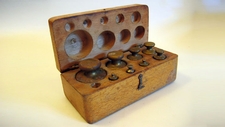Mass Comparisons

TEKS Objective
Classify matter by physical properties, including shape, relative mass, relative temperature, texture, flexibility, and whether material is a solid or liquid.
Essential Understanding
The student knows that matter has physical properties and those properties determine how it is described, classified, changed, and used.
Science Background
Mass, Weight and Gravity: School for Champions (website) - Illustrated definitions of weight and mass, and how they are measured.
Mass, Weight and Gravity
by Ron Kurtus, www.school-for-champions.com
Primer Balance Activity Guide: Ohaus Corporation (PDF) - Second grade students are not learning about measurement using standard units. They are, however, investigating how heavy or light something is, and comparing the weights of different objects, sometimes through the use of balance scale. Teachers will find that this activity guide provides excellent background information about the construction of a double pan balance, and how it works.
Primer Balance Activity Guide
Ohaus Corporation, http://dmx.ohaus.com
Signature Lesson
Mass of Maize: Learn NC (website) - Students use a balance scale to compare and rank five different corn products based on mass. Includes assessment and a downloadable student sheet.
- Supporting Lessons
- Extensions
- Assessment Ideas
- Literature Connections
- Related
TEKS - Additional Resources
Supporting Lessons
Shape and Space (Measurement): Learn Alberta (PDF) - This 50-page teacher guide for use with second grade students has 16 sample activities on measurement and mass, and written assessment ideas and worksheets.
Elaboration Lessons and Extensions
Shape and Space (Measurement): Learn Alberta (PDF) - This 50-page teacher guide for use with second grade students has 16 sample activities on measurement and mass, and written assessment ideas and worksheets.
Shape and Space (Measurement)
Learn Alberta, Government of Alberta , www.learnalberta.ca
Assessment Ideas
Comparing Weights: Education.com (website) - Two printable worksheets that can be used to assess students’ understanding of relative weight. Click on “View Worksheet” to prompt a box inviting you to become a member. Simply click on the “X” and the sheet will download.
Literature Connections
Millions to Measure, Schwartz, D. (ISBN-13: 978-0060848064)
Weighing the Elephant, Ting-xing, Ye (ISBN-13: 978-1550375275)
Additional Resources
Tools of Science for Elementary Science: BioEd Online (video) - Begin the year with this activity, which introduces students to important science tools, such as metric rulers, thermometers and magnifiers.
Tools of Science for Elementary Science
BioEd Online, www.bioedonline.org
Masses & Springs: Physics Education Technology (website) - This simulation creates a realistic, virtual mass-and-spring laboratory. Users can explore spring motion by manipulating spring stiffness, hanging mass, initial pull, damping (friction) and gravity.
Masses & Springs
Physics Education Technology, University of Colorado, www.phet.colorado.edu
Your Weight on Other Worlds: Exploratorium (website) - Ever wonder what you might weigh on Mars or the Moon? Visit this site to find out!
Your Weight on Other Worlds
Exploratorium, www.exploratorium.edu
TEKS Navigation
Grade 2
Need Assistance?
If you need help or have a question please use the links below to help resolve your problem.

Comments